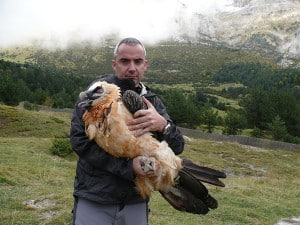Share this article
Tracking the Bearded Vulture by Satellite
Researchers using satellite technology to track massive vultures through the Pyrenees Mountains in Spain have shown that the endangered birds need a good overlap of predictable feeding sources and home ranges in order to lower the threat of extinction.

A bearded vulture was kitted out with a satellite transmitter and wing tags enabling long-distance monitoring.
Image Credit: Juan Antonio Gil (FCQ)
Bearded vultures (Gypaetus barbatus) are one of Spain’s most threatened carrion-feeding birds, with populations in the Pyrenees and other parts of Europe becoming nearly expurgated in the early 20th century. The population has been recovering in more recent decades in the Pyrenees, going from 39 breeding units in 1994 to 86 in 2014 in the Spanish autonomous community of Aragon.
Researchers used satellite telemetry to follow the birds’ movements to establish a precise range.
“Nine birds of various ages were caught and marked in order to establish the relationship between supplementary feeding points — those traditionally known as ‘rubbish tips’ and specifically established sources of food throughout the Pyrenees — and these birds’ movements,” said Pascual López, a coauthor of the study published in the journal Aldeola recently.
The results showed bearded vulture range with unprecedented precision, revealing that some birds travelled as much as 8,880 square miles while others moved around as little as 695 square miles to make an average home range of 4517 square miles per bird.
“These areas were lower than described previously in other studies published on the species in South Africa, but slightly higher than those described in the Pyrenees and the Alps using conventional techniques, which did not enable the area over which they move to be determined quite as accurately,” López said.
The study also showed that the birds used a combination of specific feeding areas with supplementary rubbish tip stops.
The finding “is especially pertinent from the point of view of conservation, as it proves once again that overlap between home ranges and predictable food sources — such as feeding areas — are crucial in order to increase survival and thus diminish the risk of the species becoming extinct in this country,” López said. “It is particularly important for young, inexperienced birds and individuals belonging to the non-breeding population of the species.”
Meanwhile, the use of satellite telemetry could be an important method for tracking spatial ecology and behavior of birds like vultures.
López said that the bearded vultures and other species like it were threatened in Spain due to the European Union closing some of the raptors’ feeding areas in 2000 when a form of the mad cow disease began appearing.
“It is a key type of work for the conservation of this group of species,” he said.
Header Image:
The bearded vulture can be found in many mountainous regions of Europe, Asia and Africa but was mostly expurgated in the Pyrenees and other parts of Europe in the early 20th century.
Image Credit: Noel Reynolds, Flickr








